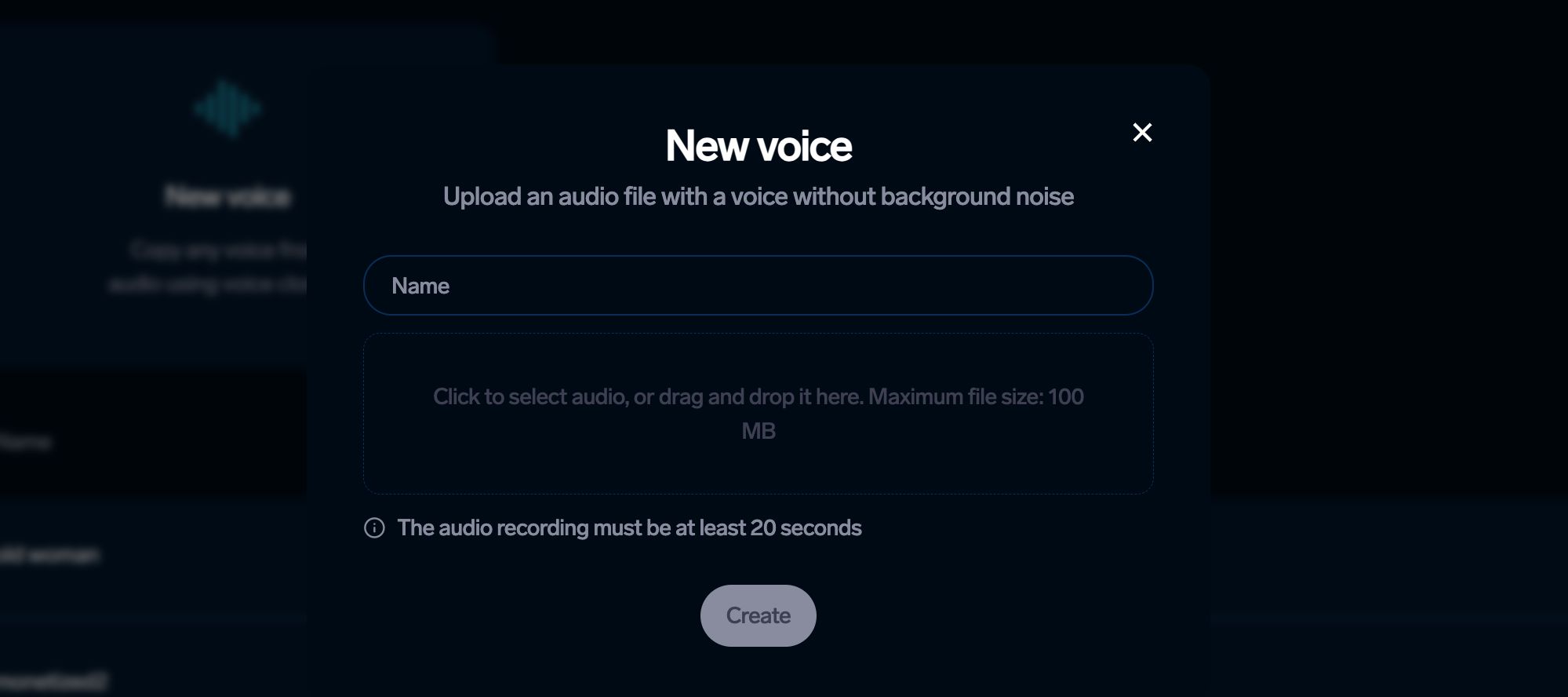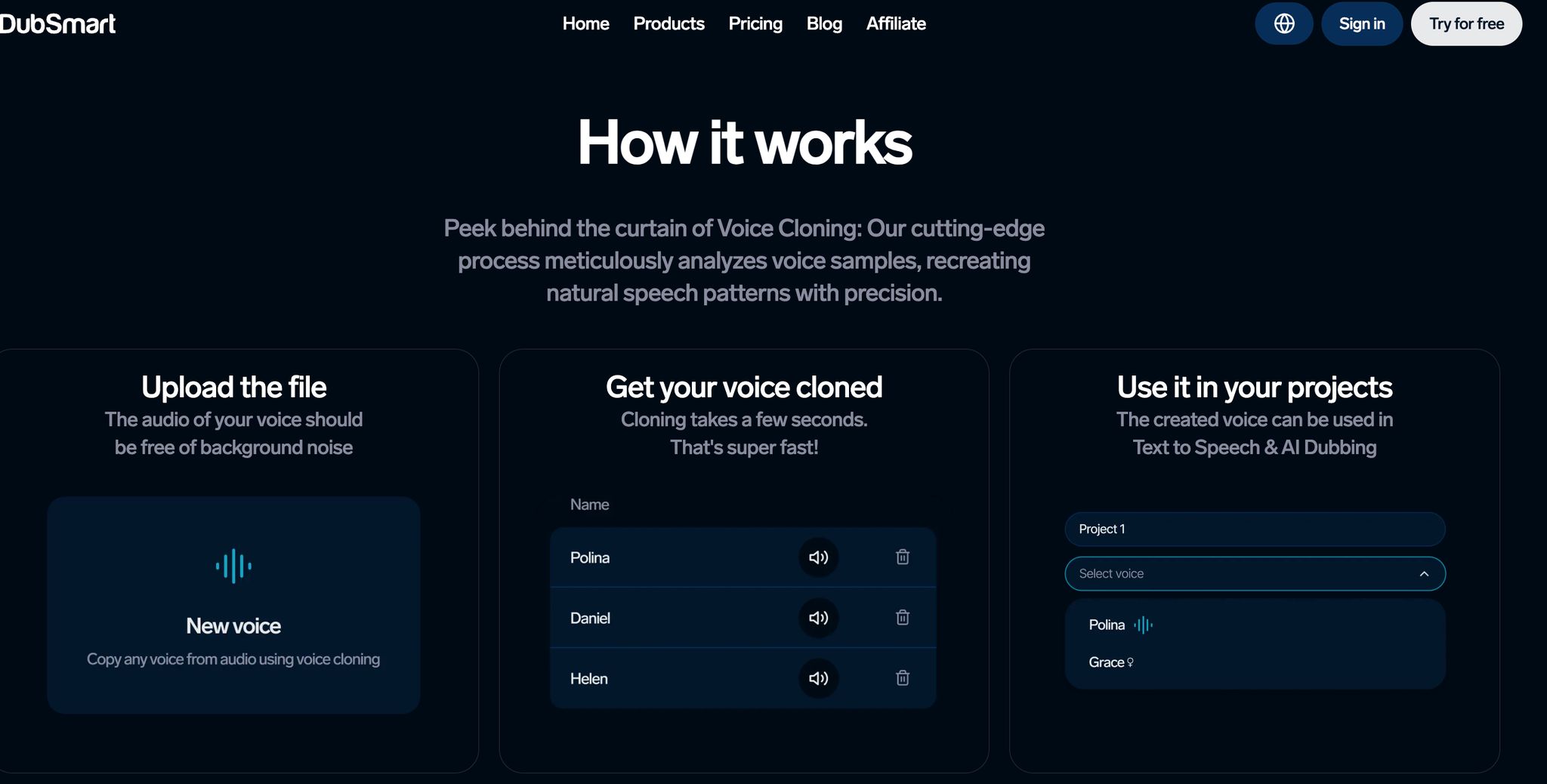AI Voice Cloning with Emotion: How It Works
AI voice cloning now replicates voices with emotional depth, transforming industries like media, customer service, and education. Here's what you need to know:
- What it does: AI clones voices by analyzing pitch, tone, and rhythm, adding emotions like joy, sadness, or empathy.
- How it works: Tools like DubSmart need just 20 seconds of audio to create expressive, multilingual voiceovers.
- Where it's used: Media voiceovers, accessibility tools, personalized customer service, and even gaming.
- Why it matters: Emotional nuance makes AI voices relatable, bridging the gap between synthetic and human communication.
Want to create lifelike voiceovers? Start with platforms like DubSmart for quick, multilingual results.
How Emotional AI Voice Cloning Works
Data and Voice Training
The process of AI voice cloning starts with gathering and training on extensive voice data. This requires high-quality recordings that capture a range of emotional expressions. These recordings are analyzed for key elements like pitch, tone, and rhythm to understand what makes a voice unique.
Clean and detailed recordings are critical for capturing the subtle emotional nuances of a voice. AI systems use this input to replicate the specific characteristics of speech, from accents to emotional undertones. Once the voice model is trained, it’s refined to add emotional depth, making the voice sound natural and expressive.
Adding Emotional Tone to Voices
To convey emotions like joy, sadness, or empathy, AI adjusts elements such as pitch, speed, tone, and rhythm. These adjustments mimic how human emotions naturally influence speech. By interpreting emotional cues from input text, the AI applies voice modulations that result in speech that feels emotionally appropriate and lifelike. Importantly, these emotional adjustments can now be applied instantly, opening up exciting possibilities for dynamic voice cloning.
Instant Voice Cloning in Real Time
Modern real-time cloning requires only minimal input to create a voice, making it immediately usable. This capability preserves emotional nuances, which is especially valuable for applications like gaming and customer service, where authentic emotional expression matters. Some key uses include:
- Interactive voice experiences in gaming
- Live customer service interactions
- Real-time content translation
- Personalized audio content creation
"AI voice cloning technology has rapidly advanced, allowing realistic voice replicas to be created with minimal audio input." - NetSPI, 2024-09-17
These advancements ensure that even during fast processing, the cloned voices maintain natural human qualities while delivering efficient performance.
Applications of Emotional AI Voice Cloning
AI Voiceovers in Media
Content creators are turning to emotional AI voice cloning to craft voiceovers in different languages while keeping the emotional tone intact. Tools like DubSmart make this possible by converting just 20 seconds of audio into multilingual voiceovers. This approach ensures that the emotional essence of the original content is preserved, no matter the language.
Enhancing Accessibility
AI voice cloning is opening doors for individuals with disabilities and those facing language barriers. For visually impaired people, it transforms written content into natural-sounding speech that carries the right emotional tone. For those with speech impairments, the technology can recreate their original voices using archived recordings, helping retain their personal identity and emotional expression. This technology is helping to create more inclusive and emotionally resonant digital experiences.
Transforming Customer Service and Personalization
Businesses are reshaping customer engagement with emotional AI voice cloning. It allows for the development of personalized voice assistants capable of responding with the right emotional tone for various scenarios. This adds a layer of emotional connection to automated systems and personalized marketing.
Organizations can now maintain consistent brand voices across different platforms while ensuring emotional depth. This is particularly impactful in areas like healthcare communication, education, and customer service, where building a personal connection is key.
These examples underscore the increasing interest in platforms like DubSmart that offer emotional AI voice cloning solutions.
AI Voice Cloning Tools and Platforms
Overview of DubSmart

DubSmart is an AI-powered voice cloning platform that delivers quick and reliable voice cloning with just 20 seconds of audio input. With support for multiple languages and the ability to preserve emotional tones, it’s a go-to solution for creators looking for efficient, high-quality voiceovers. DubSmart combines advanced AI technology with an interface that's easy to use, making it accessible for a wide range of users.
Features of DubSmart

DubSmart offers tools designed to streamline content creation:
| Feature | Description |
|---|---|
| Voice Cloning | Personalized voice cloning using 20-second samples |
| Language Support | AI dubbing available in 33 languages |
| Voice Options | Access to 30+ pre-designed voices |
| Subtitle Generation | Supports over 70 languages |
| Video Processing | Compatible with local uploads and YouTube videos (up to 1080p) |
DubSmart provides both free and paid plans, with Pro plans offering added perks like faster processing speeds and 4K video support. These features make it a flexible option for professionals across industries such as media, education, and marketing.
How DubSmart Helps Creators
DubSmart’s tools are tailored to meet the needs of content creators by speeding up multilingual production while maintaining consistent, high-quality voiceovers. The platform ensures that voices retain emotional depth, which is crucial for engaging audiences.
For professionals, enterprise-level features like 4K support and faster processing are especially useful for producing polished, high-resolution content. Its ability to work with both local files and YouTube videos adds versatility, making it suitable for everything from educational content to entertainment projects.
The platform also includes a rollover minutes feature, allowing unused minutes to carry over to the next month. This flexibility, combined with robust editing tools for dubbing projects, helps creators maintain top-notch production quality while staying on schedule.
sbb-itb-f4517a0
The Future of Emotional AI Voice Cloning
How Emotional AI Is Evolving
AI voices have traditionally struggled to convey the emotional depth that makes human speech engaging. However, breakthroughs in deep learning and access to diverse emotional speech datasets are helping AI replicate emotional expressions with greater accuracy.
| Focus Area | Current Efforts | Potential Outcomes |
|---|---|---|
| Emotional Realism | Improved neural networks and larger datasets | Smoother transitions, fewer glitches, wider range of emotions |
| Contextual Awareness | Models trained for situational understanding | Tailored emotional responses based on context |
| Multilingual Support | Analysis of emotional patterns across cultures | Consistent emotional delivery in multiple languages |
These developments are opening up new possibilities for industries to enhance user interactions with emotionally intelligent AI voices.
Expanding Uses for AI Voices
In healthcare, virtual assistants are being designed to offer empathetic responses, adapting their tone and communication style to match patients' emotional states and medical needs.
Education is also seeing a shift. AI-driven voices can now personalize learning experiences, adjusting their tone to suit students' preferences, which can boost both engagement and retention.
In gaming and virtual reality, dynamic voice systems are making characters more lifelike. These systems adjust their emotional tone based on player actions and storylines, creating a more immersive experience.
Mental health support is another area where AI voices are showing promise. They could provide emotionally sensitive support during self-help exercises or between therapy sessions, especially in regions with limited access to mental health resources.
Key areas for future development include:
-
Ethical and Inclusive Design
- Ensuring privacy in voice replication
- Making the technology accessible to diverse user groups
-
Reliable Performance and Integration
- Maintaining emotional accuracy
- Smooth integration into various platforms
As emotional AI voice technology continues to advance, it will unlock new ways to create more natural and engaging user experiences across a wide range of industries.
Summary of Key Points
Emotional AI voice cloning is changing the way audio content is created by mimicking human voices with emotional nuance. This technology has opened up new possibilities in areas like accessibility, education, and customer engagement by delivering expressive and natural-sounding voices across various languages and settings.
Here’s how it’s making an impact:
- Media and Entertainment: Produces multilingual content efficiently while maintaining consistent emotional depth.
- Accessibility: Improves audio experiences for a wide range of users.
- Customer Interactions: Creates personalized experiences with emotionally relevant responses.
- Education: Delivers engaging learning materials tailored to emotional contexts.
Next Steps for Creators
For those ready to explore emotional AI voice cloning, tools like DubSmart make it easy to get started with voice cloning in 33 languages. To make the most of this technology:
- Begin Small: Test it out with short projects like ads or social media clips to fine-tune emotional delivery.
- Focus on Quality: Use clear, expressive audio recordings to ensure accurate voice replication.
- Align with Your Audience: Choose voice tones that fit the content’s purpose and audience expectations.
As neural networks and emotional expression features continue to improve, the potential for this technology will only grow. With platforms becoming more accessible, creators are now better equipped to produce content that connects with audiences on a deeper, more emotional level.
FAQs
What is the best AI voice generator for emotion?
Picking the right AI voice generator can make a big difference when it comes to creating emotionally expressive content. One standout option is DubSmart, which offers instant voice cloning in 33 languages. It only needs 20 seconds of audio to replicate voices with emotional depth.
When evaluating AI voice generators for emotional content, focus on these important features:
| Feature | Importance |
|---|---|
| Training Efficiency | Determines how quickly the AI can learn to replicate a voice accurately |
| Language Support | Ensures emotional authenticity across various languages |
| Emotion Range | Captures a variety of emotions naturally and in context |
| Real-time Processing | Critical for live scenarios and fast content production |
To get the best results, use high-quality voice samples during the training process. DubSmart’s ability to quickly and effectively replicate emotional tones makes it a strong choice for creators who need expressive voiceovers.
"AI voice cloning replicates human voices while capturing emotional nuances through advanced algorithms."
Always ensure proper consent when cloning voices, especially for public or commercial purposes.
